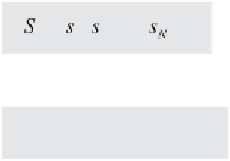Graphics Programs Reference
In-Depth Information
steps required for the algorithm to converge close enough to an optimum
solution), misadjustment (measure of the amount by which the fi nal value
of the mean-squared error deviates from the minimum squared error of an
optimal fi lter, e.g., Wiener 1945, Kalman and Bucy 1961), and tracking (the
capability of the fi lter to work in a nonstationary environment, i.e., to track
changing statistical characteristics of the input signal) (Haykin 1991).
The simplicity of the least-mean-squares (LMS) algorithm, originally de-
veloped by Widrow and Hoff (1960), has made it the benchmark against
which other adaptive fi ltering algorithms are tested. For applications in earth
sciences, we use this fi lter to extract the noise from two signals
S
and
X
,
both containing the same signal
s
, but uncorrelated noise
n
1
and
n
2
(Hattingh
1988). As an example, consider a simple duplicate set of measurements on
the same material, e.g., two parallel stable isotope records from the same
foraminifera species. What you will expect are two time-series with
N
ele-
ments containing the same desired signal overlain by different uncorrelated
noise. The fi rst record is used as the primary input
S
and the second record
is the reference input
X
.
and
As demonstrated by Hattingh (1988), the required noise-free signal can be
extracted by fi ltering the reference input
X
using the primary input
S
as the
desired response
d
. The minimum error optimization problem is solved by
the L2-norm (least-mean-square). The mean-squared error
e
i
2
is a second-or-
der function of the tap weights in the nonrecursive fi lter. The dependence of
e
i
2
on the unknown tap weights may be seen as a multidimensional parabo-
loid with a uniquely defi ned minimum point. The tap weights corresponding
to the minimum point of this error performance surface defi ne the optimum
Wiener solution (Wiener 1945). The value computed for the weight vector
W
using the LMS algorithm represents an estimator whose expected value
approaches the Wiener solution as the number of iterations approaches infi n-
ity (Haykin 1991). Gradient methods are used usually to reach the minimum
point of the error performance surface. For simplifi cation of the optimiza-
tion problem, Widrow and Hoff (1960) developed an approximation for the
required gradient function that can be computed directly from the data. This
leads to a simple relation for updating the tap-weight vector
W
.











